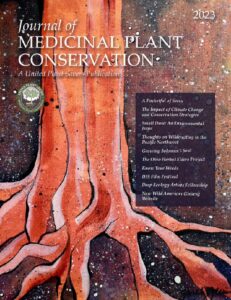Guilford, Vermont
Sanctuary Steward: Martha Rabinowitz
 This is land that was used by a dairy farm for pasture, corn, and hay. Over the years the forest has returned, maple with beech, hemlock, pine, and birch. I am starting to turn my attention to medicine from trees, but I am just a beginner at that.
This is land that was used by a dairy farm for pasture, corn, and hay. Over the years the forest has returned, maple with beech, hemlock, pine, and birch. I am starting to turn my attention to medicine from trees, but I am just a beginner at that.
Some acres here are still hayed, certified organic, and that is where I gather many herbs such as alfalfa (Medicago sativa), red clover (Trifolium pratense), motherwort (Leonurus cardiaca), milkweed (Asclepias syriaca), and more. So many common herbs are very medicinal, and I believe that using them is one way to preserve the more rare species. The hayfields are loved by pollinators and butterflies. My lawn is really just a close mowed field and has violets (Viola spp.), dandelions (Taraxacum officinale), plantain (Plantago spp.), and more. I have counted over 30 species growing.
In the forest I have seen a natural return of herbs as the canopy closes and the soil regenerates. The first near my house was blue cohosh (Caulophyllum thalictroides). Last year I found maidenhair fern (Adiantum pedatum), and in the fall I found ginseng (Panax quinquefolius) with seeds. I planted them right near the mother. I was so excited!
I also have a patch of goldenseal (Hydrastis canadensis) that I planted with roots from someone across town. My patch has grown so well, it is my pride and joy. One year there were so many seeds, I planted them in a corner of the patch, and they have sprouted. I intend to plant them out in the forest next fall in spots where I think they will thrive. Last year all my seeds disappeared, and I suspect the local blue jays. I hope some of them sprout wherever they fall! I did have to put a good fence around my little plot to keep out deer, and I am always looking at the surrounding trees and adjusting the amount of light they get.
I also have rescued bloodroot (Sanguinaria canadensis) that was on the edge of the road left by the road crew machinery, and just a few roots have produced babies that sprout up all over the place and are so beautiful in the spring. In the same way I have adopted some black cohosh (Actaea racemosa) that appeared in a neighbor’s garden. He was horrified, but once he found out that I thought it was a great plant, he decided he thought so, too and has kept his patch going. I also moved leeks and trillium (Trillium spp.) from where they would have been destroyed. My black birches have produced chaga (Inonotus obliquus) as well.
Much of my “gardening” is fighting at the field-forest boundary with invasive plants. Bittersweet (Celastrus spp.) is brought in by the birds and grows rampant. Black swallowwort (Cynanchum louiseae) is taking hold, and I actually burned a fire over where it lives, since it’s so hard to get rid of. I think it helped, but I have to keep after it. Spotted knapweed (Centaurea maculosa) is another, and Japanese barberry (Berberis thunbergii) far outgrows the amount I could ever use for dye or medicine and brings in ticks.
I try to appreciate every plant, but some take over too much. So a lot of my gardening is not in a little spot but in keeping the architecture of the forest and swamp available for the wild plants and animals to regenerate. I feel so blessed to do this work!





